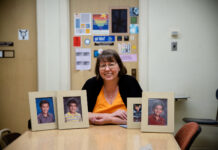Anthropology professor Brian Pierson stands with his posse of skeletons in the Anthropology building at Pierce College. Photo by: David Paz
His office is a small cubicle, simple, organized and grey space. Three things stand out, two frames that display a Neanderthal and the Menino Lepedo child, and him.
He wears an eggplant purple shirt with beaded necklaces to celebrate the start of mardi gras.
The dominant and loud voice that exits him almost echoes in the empty faculty office.
“Happy Mardi Gras,” Pierce College anthropology professor Brian Pierson said.
The excitement comes from his years as a New Orleans resident, one of the various places he lived in before becoming a full-time professor at Pierce.
“I was there right when Katrina hit. I had been there for two months. We got evacuated, and I came back out here [Los Angeles], worked on 300 [the film], then I went back. I was there from 2005 to 2011,” Pierson said.
Pierson is from Ann Arbor, Michigan. After graduating high school, he moved to Tucson, Arizona for about a year, went back to Michigan and then went to art school in Pittsburg, Penn. He then moved to Phoenix, Arizona for three years and then lived in Los Angeles for 10 years where he worked in the film industry.
In his 10 years in L.A., Pierson decided to go back to school. He attended Los Angeles Valley College and transferred to UCLA where he graduated with a degree in physical anthropology. He moved to New Orleans to get his graduate degree at Tulane University where he got his PhD.
His return to New Orleans was filled with job memories he explains in vivid detail, stories that he calls “unique and kind of a detective story in it of themselves.”
Pierson didn’t jump into anthropology right out of high school. For a long time he wanted to be a special effects artist, which led him to work in the film industry for so long.
“I wanted to be an effects artist for a long time,” Pierson said. “But then I realized that the effects field wasn’t intellectually stimulating at all, and I’ve always been really interested in anthropology. I think that it came full circle. I took a lot of the effects stuff that I learned, like sculpting, and put that back in anthro. So it’s using the same techniques that I was doing in art, only applying it with a little bit more intellectual stuff.”
Pierson is in his second year of tenure at Pierce and teaches anthropology 101 and 102.
Not only a professor, Pierson is an on call for any local cases and is one of the only anthropologists who does forensic facial reconstruction.
Professor of anthropology and archaeology Joseph Eisenlauer has been at Pierce for about 20 years and was on the committee that hired Pierson.
“You can’t go to sleep in his class, he has a loud booming voice,” Eisenlauer said. “He’s very excited about teaching, and we’re very glad to have him. A lot of candidates applied for his job, and the fact that we chose him, I was on that committee, it says something about the quality of his teaching ability.”
Although Eisenlauer’s concentration is archaeology, all of Pierce’s anthropology instructors have to teach biological anthropology at some point. Because that is Pierson’s area of expertise, Eisenlauer finds that in listening to some of Pierson’s lectures, he sometimes changes his.
“I’m an archaeologist and he’s a biological anthropologist,” Eisenlauer said. “So in listening to some of his lectures, I’ve realized that some of the things I was saying are based on previous interpretations and that there are newer interpretations now. In a few instances I have changed my lectures to reflect things that he’s said because I know that it represents the more current opinion.”
Unable to give an answer as to what is his favorite class to teach, Pierson said he enjoys teaching 101, which focuses on the physical aspect of anthropology.
Soon Pierson will have a favorite class to teach, one that he said will be his “baby.”
Anthropology 119 will be the first forensics class at Pierce.
“I just got a forensics class going,” Pierson said. “We’re going to start teaching that next year, spring 2016 is what we’re aiming for. That’ll be my baby, that’s something that I put a lot of heart and soul into. With the forensics class, which is 119, you’ll be able to get a lot more detail and a lot deeper into what it is and how it is done, and explore a lot more of what really interests people in forensics.”
Pierson is excited about what the passing of proposition 30 means for himself, Eisenlauer and anthropology professor Erin Moran.
“We’re going to be able to do more classes, we’re going to start pandering to our interests a lot more, being myself, Dr. Erin Moran and Dr. Eisenlauer. We’re going to be able to start exploiting the things that we’re really interested in.”
Hired at the same time as Pierson, Moran is a cultural anthropologist whose concentration differs from Pierson’s but still pulls inspiration from his teachings.
“He’s our physical anthropologist, so he’s the expert on that. I’ve used a number of his memory tricks when I teach it,” Moran said. “He’s a super creative interesting person, who’s really interested in a lot of stuff and sharing his knowledge, so I find it really interesting to talk to him because I always learn something, and I’m always inspired and motivated by his creativity and passion.”
Pierson has accomplished so much, but he wants more.
“I want more of it. It’s all fun, it’s all exciting, and it never gets old,” he said.


